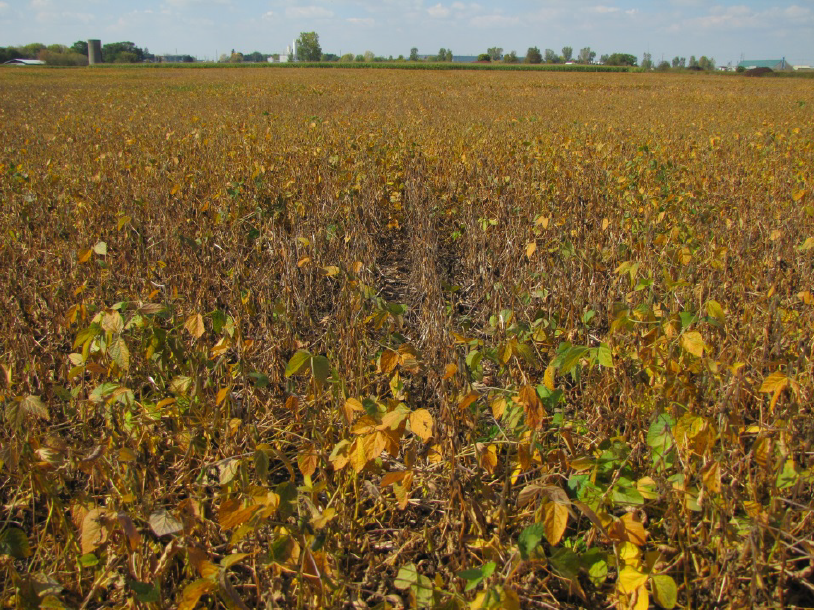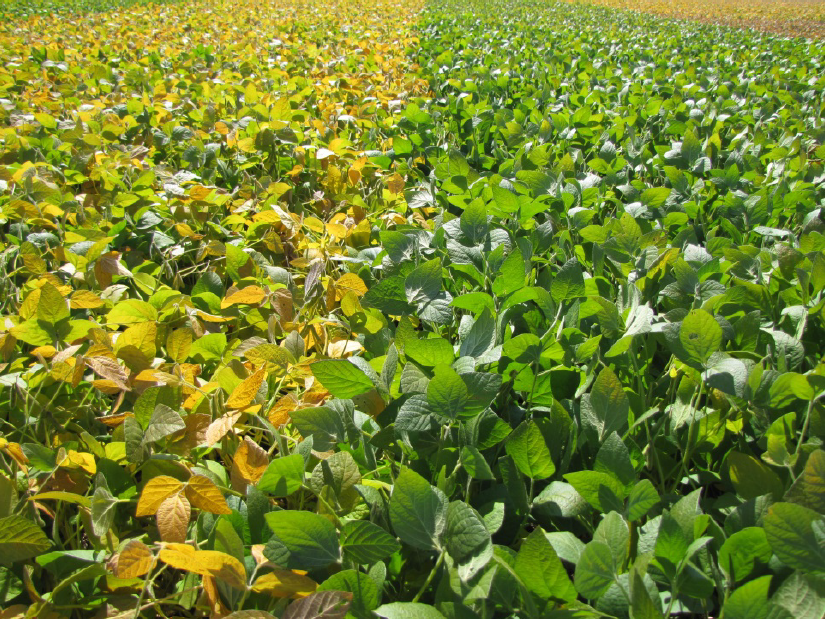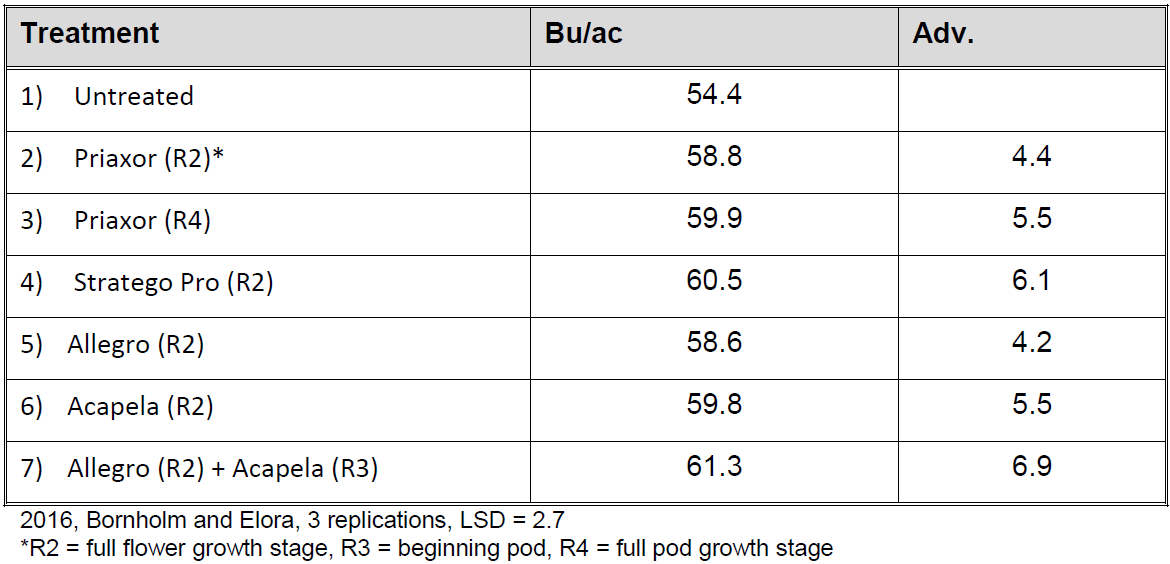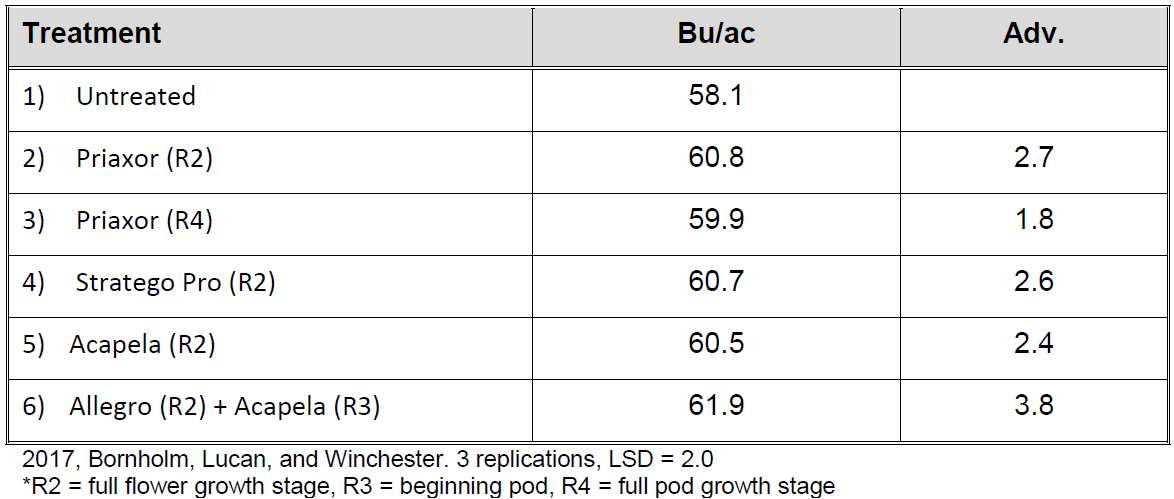Purpose
Foliar fungicides are an important management tool to suppress white mould. They also aid in the control of foliar leaf diseases such as septoria brown spot and frogeye leaf spot. Seed size and seed quality can be improved especially when there is significant disease pressure. Field experience has shown that foliar fungicides will significantly improve yields when there is considerable white mould pressure. The yield impact in fields with minimal white mould or other disease pressure is less clear. Trials were designed to assess the best fit for fungicides with one application or with two spray applications.
 Image 1: White mould infected plants in the center of the picture have died prematurely.
Image 1: White mould infected plants in the center of the picture have died prematurely.
Methods
Eleven trials were conducted in the 2015, 2016 and 2017. The locations of these trials were Bornholm, Lucan, Elora, and Winchester. The treatments applied in 2015 were:
- Untreated Control
- Priaxor (R2)*
- Priaxor (R4)**
- Priaxor (R2) + Acapela (R4)
*R2 = full flower growth stage, **R4 = full pod growth stage
Foliar application of fungicides was completed by a customized spray applicator at the various plant growth stages indicated in the treatment list. All treatments were replicated 3 times. 20 US gallons of water per acre were applied.
In 2016 the treatment list was:
- Untreated Control
- Priaxor (R2)
- Priaxor (R4)
- Stratego Pro (R2)
- Allegro (R2)
- Acapela (R2)
- Allegro (R2) + Acapela (R3)
In 2017 the treatment list was:
- Untreated ControlPriaxor (R2)
- Priaxor (R2)
- Priaxor (R4)
- Stratego Pro (R2)
- Acapela (R2)
- Allegro (R2) + Acapela (R3)
Results
White mould was present at two sites during the three years of this study but disease pressure was low. Other leaf disease incidence was extremely low. Average trial yields ranged from 50 to 61 bu per acre. It was observed that soybean maturity could be slightly delayed with the application of foliar fungicides. See Image 2. These delays were generally less than 2 days in the fall and did not hinder harvest timing.
Table 1. Soybean Yield Response to Fungicide Application in 2015

A positive yield response of 1.8 bu/ac was observed when Priaxor was applied at the R2 or R4 soybean growth stage. See Table 1. Two applications of a foliar fungicide more than doubled the yield response to 5.2 bu per acre.
 Image 2: Left side of picture is untreated. Right side of the picture was sprayed twice with a foliar fungicide.
Image 2: Left side of picture is untreated. Right side of the picture was sprayed twice with a foliar fungicide.
Table 2. Soybean Yield Response to Fungicide Application in 2016

Although the 2016 season was relatively dry at the test locations in late summer yield were above average. Table 2 shows that a positive yield response of over 4 bu per acre was observed when Priaxor was applied at the R2 or R4 soybean growth stage. Two applications of a foliar fungicide increased yield response to almost 7 bu per acre.
Table 3. Soybean Yield Response to Fungicide Application in 2017

There was a positive yield response to the application of fungicides except at the R4 (full pod set) growth stage. Two applications showed a yield response of 3.8 bu per acre.
Summary
- Positive yield responses were observed when fungicides were applied at the R2 and R4 growth stages in 2015. There was no yield response to the R4 growth stage during the 2017 growing season. The yield response on average across the three years of this study to spraying Priaxor was 3.0 bu/ac when sprayed at the R2 growth stage.
- Two applications of a fungicide provided higher and more consistent yield gains. Averaged across the three years of this study there was a 5.3 bu/ac yield gain. Since disease pressure was low these yield gains were not anticipated and support further investigation into the use of foliar fungicides on soybeans.
- Although white mould pressure was limited it was evident that for white mould suppression two applications are necessary for best results. Likely the best timing is late R1 (early R2) and then again 10-14 days later.
- For general leaf disease pressure one application at the R2-R3 is likely the best application window. Earlier research has shown that spraying during the vegetative stages is too early and provides little benefit.
Acknowledgements
We would also like to thank Pioneer, Dekalb, Syngenta, Dupont, and BASF for materials provided for this project.
Project Contacts:
Horst Bohner, OMAFRA, horst.bohner@ontario.ca
